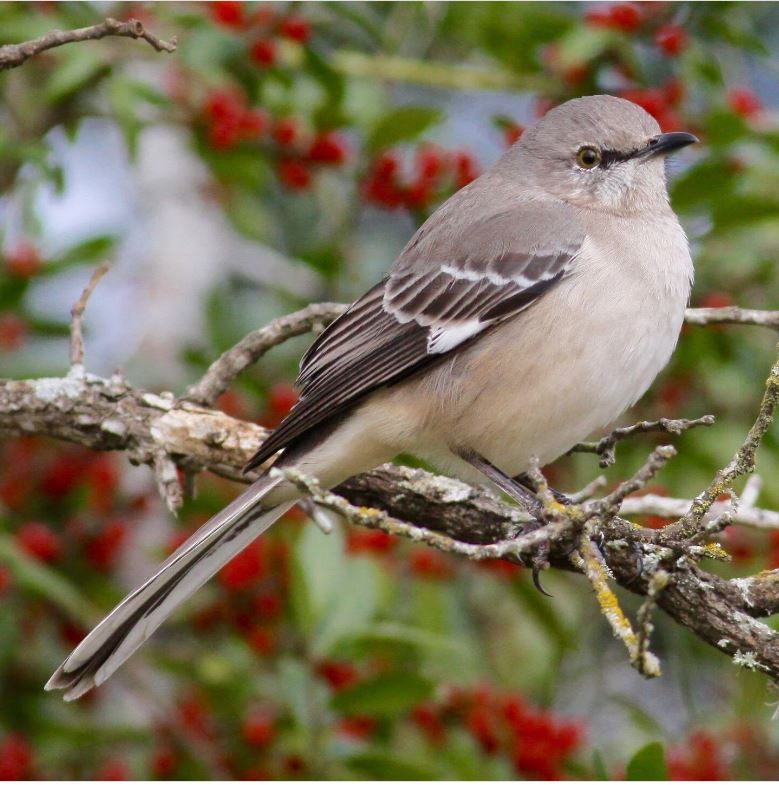
The northern mockingbird has been the state bird of Texas since 1927 when the state legislature declared, “WHEREAS, Ornithologists, musicians, educators and Texans in all walks of life unite in proclaiming the mocking bird the most appropriate species for the state of Texas, as it is found in all parts of the state, in winter and in summer, in the city and in the country, on the prairie and in the woods and hills, and is a singer of distinctive type, a fighter for the protection of his home, falling, if need be, in its defense, like any true Texan.”
Within its widespread territory the mockingbird is easily recognized by its long tail and distinctive white wing bars. Yet there is grumbling in the ranks. This past January, several serious birdwatchers on an email discussion list announced that it is time to find a new state bird. After all, the mockingbird is present in the lower 48 states and is the state bird of Florida, Mississippi and Tennessee. The disgruntled felt that Texas needed a state bird that was truly distinctive.
Some birders argued in support of the golden-cheeked warbler, a species that is endangered and has a breeding range that is entirely within the Lone Star State. Others supported flashy birds, like the painted bunting. No state has this colorful and beautiful species as its state bird. Still others nominated common species, including the tufted titmouse. At least one person nominated the great-tailed grackle.
Cooler heads prevailed and most of the discussants came to realize that the mockingbird should remain the official state bird of Texas. After all, many of the proposed species have limited range in Texas and many non-birders would be hard pressed to recognize them — except for perhaps the grackle.
There is so much to like about the mockingbird and it is a well-named species. Along with thrashers and catbirds, mockingbirds belong to a family of birds called mimids. As the name suggests, these species mimic other birds. The northern mockingbird, however, surpasses all other species in its ability to imitate sounds.
Ornithologists tell us that a single male mockingbird can learn about 200 songs during its lifetime. However, at any point in time, the typical mockingbird has a repertoire of 20 to 25 songs. While most of these songs are those of other birds, they can mimic insects and even human sounds. Some mockingbirds have been known to imitate chainsaws, squeaky gates and car horns.
Mockingbirds will often sing throughout the day and even into the night. I was camping with a friend a few years ago in West Texas and we were serenaded all night long by a mockingbird. The next morning my friend fumed, “That bird was annoying!” Ornithologists tell us that night singing may be due to the fact that a male has yet to find a mate. Upon learning this, my friend was quick to forgive.
Mockingbirds typically incorporate other bird songs in groups of three. For example, birds in my neighborhood might start their recital by singing three notes of a blue jay: “Jay, jay, jay. Jay, jay, jay. Jay, jay, jay.” Then the bird might switch to a tufted titmouse: “Peter, peter. Peter, peter. Peter, peter.” And then it might switch to a Carolina wren: “Tea kettle, tea kettle, tea kettle. Tea kettle, tea kettle, tea kettle. Tea kettle, tea kettle, tea kettle.” The same mockingbird incorporates other bird songs before revisiting previously mimicked songs.
I have been fooled by mockingbirds. On many occasions, they have led me to believe I was hearing another bird. Only when they switch songs do I realize that it is in fact a mockingbird singing. The northern mockingbird is an amazing mimic.
Sometimes when I am traveling to a different region or state, mockingbirds may alert me to the presence of other species. For example, I recall distinctly watching and hearing a mockingbird in Southeast Arizona mimic a Cactus wren. Sure enough: a few minutes later a cactus wren alit on a fence and sang its distinctive song. Mockingbirds know their territory.
Mockingbirds also anticipate the arrival of migrating birds. As spring days get longer, I have heard mockingbirds mimic Mississippi kites and chuck-will’s-widows weeks before they arrive back in the Brazos Valley. It’s as if mockingbirds are beckoning home the return of old friends.
Besides being amazing vocalists, mockingbirds can be territorial. They are quick to attack and drive away cats, crows and even humans they see as threats to their nests and chicks. Few mockingbirds attack humans, but is best to stay clear of known nests.
In Harper Lee’s, “To Kill a Mockingbird,” Miss Maudie explained to Scout: “Mockingbirds don’t do one thing but make music for us to enjoy. They don’t eat up people’s gardens, don’t nest in corncribs, they don’t do one thing but sing their hearts out for us. That’s why it’s a sin to kill a mockingbird.” Mockingbirds bring us joy, and they can also teach us a lot about other avian wildlife in our presence. I for one am delighted that the northern mockingbird is the official state bird of Texas.
David Scott is a long-time member of the Rio Brazos Audubon Society and a retired professor in the Department of Recreation Park and Tourism Sciences at Texas A&M University.
